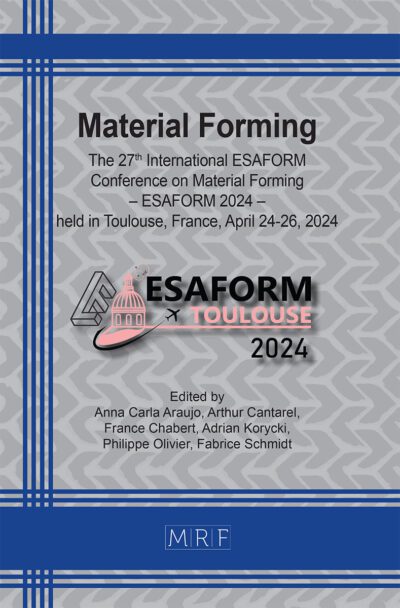Experimental and numerical investigation of the influence of rolling-induced sheet metal deformation on SPR joints
Malte Christian Schlichter, Özcan Harabati, Jean-Patrick Ludwig, Max Böhnke, Christian R. Bielak, Mathias Bobbert, Gerson Meschut
Abstract. In the development of advanced lightweight automotive solutions, self-piercing riveting (SPR) offers the possibility of joining multi-material structures to fulfil a wide variety of requirements. With regard to the entire process chain, production-related pre-deformations of the parts to be joined can influence the geometric shape and load capacity of SPR joints. Various studies have investigated the influence of pre-stretched sheet materials, in the sense of pre-drawing processes, on the formation of SPR joints. The impact of pre-stretching sheet metals on the formation of their geometrical characteristics and the shear-tensile strength of SPR processes was observed [1]. Pre-rolled semi-finished products are also joined together in mixed material automotive structures, e.g. tailor rolled blanks. This work aims to investigate the influence of pre-rolled joining parts on the geometric formation and load-carrying capacity of SPR joints. For this purpose, sheets of metal are cold-formed using a rolling process to induce a defined strain-hardening state in the material and then joined in various combinations. As the degree of deformation increases, the rolling of samples can lead to minimal accumulation of damage in the sheet materials, which can influence the joint behaviour. The rolling process, as well as the subsequent joining process, are also investigated by FEM. The influence of pre-rolled semi-finished products on the strength of the SPR joints is investigated.
Keywords
Self-Piercing Riveting, Rolling, Pre-Deformation, Characterisation
Published online 5/7/2025, 10 pages
Copyright © 2025 by the author(s)
Published under license by Materials Research Forum LLC., Millersville PA, USA
Citation: Malte Christian Schlichter, Özcan Harabati, Jean-Patrick Ludwig, Max Böhnke, Christian R. Bielak, Mathias Bobbert, Gerson Meschut, Experimental and numerical investigation of the influence of rolling-induced sheet metal deformation on SPR joints, Materials Research Proceedings, Vol. 54, pp 1364-1373, 2025
DOI: https://doi.org/10.21741/9781644903599-148
The article was published as article 148 of the book Material Forming
![]() Content from this work may be used under the terms of the Creative Commons Attribution 3.0 license. Any further distribution of this work must maintain attribution to the author(s) and the title of the work, journal citation and DOI.
Content from this work may be used under the terms of the Creative Commons Attribution 3.0 license. Any further distribution of this work must maintain attribution to the author(s) and the title of the work, journal citation and DOI.
References
[1] O. Hahn and J. R. Kurzok. Umformtechnisches Fügen vorverformter Halbzeuge. Shaker 1. Stahl, 1998.
[2] P.K. Mallick, Materials, design, and manufacturing for lightweight vehicles, Second edition, Woodhead Publishing, Duxford, 2021. https://doi.org/10.1016/B978-0-12-818712-8.00008-2
[3] M. Merklein, M. Johannes, M. Lechner, A. Kuppert, A review on tailored blanks-Production, applications and evaluation, Journal of Materials Processing Technology 214 (2014) 151-164. https://doi.org/10.1016/j.jmatprotec.2013.08.015
[4] N. Becker, A. Gräber, H.P. Liebig, Fügen durch Umformen, in: K. Lange (Ed.), Sonderverfahren, Prozeßsimulation, Werkzeugtechnik, Produktion, 2., völlig neubearb. und erw. Aufl., Springer, Berlin, 1993, pp. 271-305. https://doi.org/10.1007/978-3-642-58047-5_12
[5] DVS/EFB Merkblatt 3410 Stanznieten-Überblick, 2014.
[6] O. Hahn and J. R. Kurzok. Umformtechnisches Fügen vorverformter Halbzeuge. Shaker 2. Aluminium, 1998.
[7] L. Han, K.W. Young, A. Chrysanthou, J.M. O’Sullivan, The effect of pre-straining on the mechanical behaviour of self-piercing riveted aluminium alloy sheets, Materials & Design 27 (2006) 1108-1113. https://doi.org/10.1016/j.matdes.2005.04.002
[8] Y. Ma, M. Lou, Y. Li, Z. Lin, Effect of rivet and die on self-piercing rivetability of AA6061-T6 and mild steel CR4 of different gauges, Journal of Materials Processing Technology 251 (2018) 282-294. https://doi.org/10.1016/j.jmatprotec.2017.08.020
[9] Z. Xue, X. Wang, C. Xu, Z. Chen, X. Feng, Q. Zhou et al., Equivalent characterization of pre-strained material properties and mechanical behavior prediction of steel/aluminum self-piercing riveted joints, Thin-Walled Structures 182 (2023) 110243. https://doi.org/10.1016/j.tws.2022.110243
[10] C. Wang, Z. Du, A. Cheng, Z. He, Numerical investigation of joinability and forming quality improvement on self-piercing riveting process with varying sheet stack combinations, Thin-Walled Structures 201 (2024) 112017. https://doi.org/10.1016/j.tws.2024.112017
[11] G. Meschut, P. Heyser, M. Merklein, S. Wiesenmayer, W. Flügge, C. Scharr et al., Konzeption einer adaptiven Prozesskette für das mechanische Fügen, Europäische Forschungsgesellschaft für Blechverarbeitung e.V, Hannover, 2022.
[12] C.R. Bielak, M. Böhnke, M. Bobbert, G. Meschut, Experimental and Numerical Investigation on Manufacturing-Induced Pre-Strain on the Load-Bearing Capacity of Clinched Joints, The 25th International Conference on Material Forming 926 (2022) 1516-1526. https://doi.org/10.4028/p-5d009y
[13] M. Otroshi. Damage modeling in the numerical simulation of mechanical joining processes. Shaker Verlag, 2022.
[14] M. Nahrmann. “Deformation and failure models of high strength steels for finite element simulations.” (2022).
[15] G.R. Johnson, W.H. Cook, Fracture characteristics of three metals subjected to various strains, strain rates, temperatures and pressures, Engineering Fracture Mechanics 21 (1985) 31-48. https://doi.org/10.1016/0013-7944(85)90052-9
[16] Novelis GLobal Automotive, EN AW-6014 T4 – Material Data Sheet: Novelis Advanz 6F – e170 (2019).
[17] Salzgitter Flachstahl, HCT590X+Z: Mehrphasenstähle zum Kaltumformen – Dualphasenstähle, https://www.salzgitter-flachstahl.de/fileadmin/footage/MEDIA/gesellschaften/szfg/informationsmaterial/produktinformationen/feuerverzinkte_produkte/deu/hct590x.pdf.
[18] M. Böhnke, F. Kappe, M. Bobbert, and G. Meschut. “Influence of various procedures for the determination of flow curves on the predictive accuracy of numerical simulations for mechanical joining processes.” Materials Testing 63, no. 6 (2021): 493-500. https://doi.org/10.1515/mt-2020-0082












